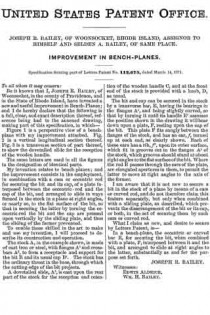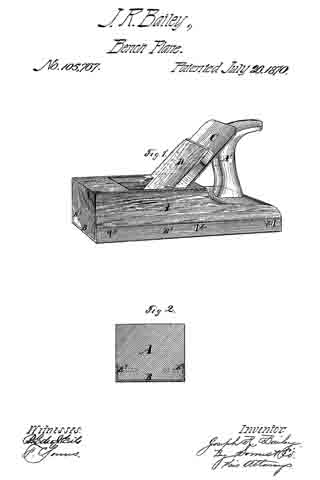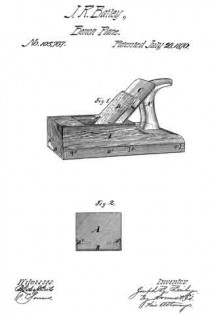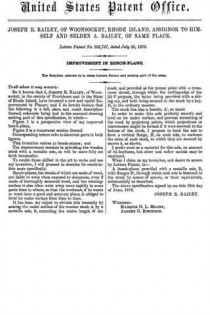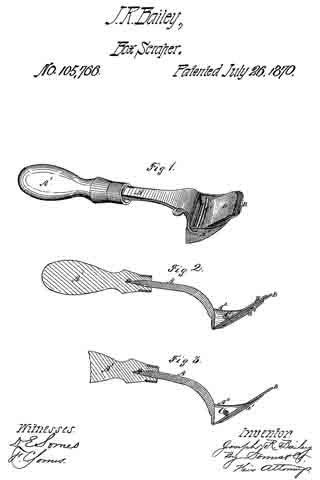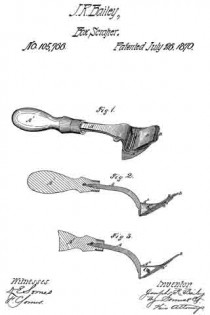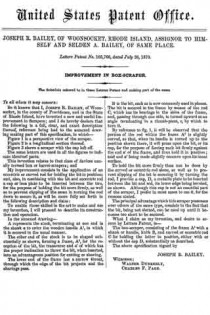No. 112,675 – Improvement In Bench-Planes (Joseph R. Bailey) (1871)

UNITED STATES PATENT OFFICE.
_________________
JOSEPH R. BAILEY, OF WOONSOCKET, RHODE ISLAND, ASSIGNOR TO
HIMSELF AND SELDEN A. BAILEY, OF SAME PLACE.
IMPROVEMENT IN BENCH-PLANES.
_________________
Specification forming part of Letters Patent No. 112,675, dated March 14, 1871.
_________________
To all whom it may concern:
Be it known that I, JOSEPH R. BAILEY, of Woonsocket, in the county of Providence, and in the State of Rhode Island, have invented a new and useful Improvement in Bench-Planes; and I do hereby declare that the following is a full, clear, and exact description thereof, reference being had to the annexed drawing, making part of this specification, in which —
Figure 1 is a perspective view of a bench-plane with my improvement attached. Fig. 2 is a vertical longitudinal section thereof. Fig. 3 is a transverse section of part thereof, to show the dovetailed slide for the reception of the wooden handle.
The same letters are used in all the figures in the designation of identical parts.
My invention relates to bench-planes; and the improvement consists in the employment, in combination with a cam or eccentric rod for securing the bit and its cap, of a plate interposed between the eccentric-rod and the cap of the bit, and arranged to slide in ways formed in the stock in a plane at right angles, or nearly so, to the flat surface of the bit, so that in securing the latter by turning the eccentric-rod the bit and the cap are pressed upon vertically by the sliding plate, and thus the sliding of the former prevented.
To enable those skilled in the art to make and use my invention, I will proceed to describe its construction and operation.
The stock A, in the example shown, is made of cast iron or steel, with flanges A1 and cross-bars A2, to form a receptacle and support for the bit B and its usual cap B’. The stock has the ordinary throat in the base, through which the cutting-edge of the bit projects.
A dovetailed slide, A3, is cast upon the rear part of the stock for the reception and retention of the wooden handle C, and at the front end of the stock is provided with a knob, D, as usual.
The bit and cap can be secured in the stock by a transverse bar, E, having its bearings in the flanges A1, and being slightly curved, so that by turning it until its handle E’ assumes the position shown in the drawing it will bear down upon a plate, F, resting upon the cap of the bit. This plate F fits snugly between the flanges of the stock, and has an ear, f, turned up at each end, as clearly shown. Each of these ears has a rib, f’, upon its outer surface, which fit in grooves cut in the flanges A1 of the stock, which grooves should stand at about right angles to the fiat surface of the bit. Where the rod E passes through the ears of the plate, are elongated apertures in them, to permit the latter to move at right angles to the axis of the former.
I am aware that it is not new to secure a bit in the stock of a plane by means of a cam or curved rod, and do not therefore claim this feature separately, but only when combined with a sliding plate, as described, which prevents the disarrangement of the bit or its cap, or both, in the act of securing them by such cam or curved rod.
What I claim as new, and desire to secure by Letters Patent is —
In a bench-plane, the eccentric or curved bar E, for securing the bit, when combined with a plate, F, interposed between it and the bit, and arranged to slide at right angles to the latter, substantially as and for the purpose set forth.
JOSEPH R. BAILEY.
Witnesses:
EDWIN ALDRICH,
WM. H. BAILEY.


